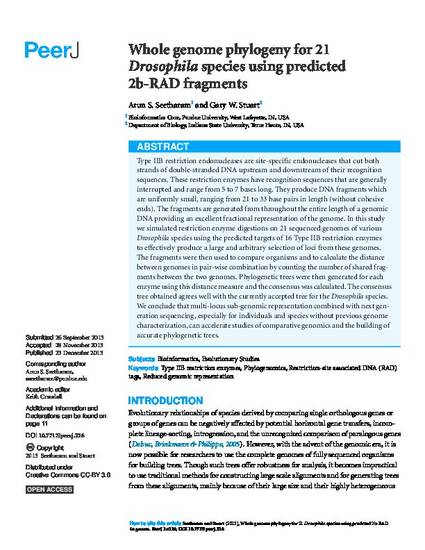
Article
Whole genome phylogeny for 21 Drosophila species using predicted 2b-RAD fragments
PeerJ
(2013)
Abstract
Type IIB restriction endonucleases are site-specific endonucleases that cut both strands of double-stranded DNA upstream and downstream of their recognition sequences. These restriction enzymes have recognition sequences that are generally interrupted and range from 5 to 7 bases long. They produce DNA fragments which
are uniformly small, ranging from 21 to 33 base pairs in length (without cohesive ends). The fragments are generated from throughout the entire length of a genomic DNA providing an excellent fractional representation of the genome. In this study we simulated restriction enzyme digestions on 21 sequenced genomes of various
Drosophila species using the predicted targets of 16 Type IIB restriction enzymes to effectively produce a large and arbitrary selection of loci from these genomes. The fragments were then used to compare organisms and to calculate the distance between genomes in pair-wise combination by counting the number of shared frag-
ments between the two genomes. Phylogenetic trees were then generated for each enzyme using this distance measure and the consensus was calculated. The consensus tree obtained agrees well with the currently accepted tree for the Drosophila species. We conclude that multi-locus sub-genomic representation combined with next generation sequencing, especially for individuals and species without previous genome characterization, can accelerate studies of comparative genomics and the building of accurate phylogenetic trees.
Keywords
- Type IIB restriction enzymes,
- Phylogenomics,
- Restriction-site associated DNA (RAD) tags
Disciplines
Publication Date
2013
DOI
10.7717/peerj.226
Publisher Statement
Copyright Seetharam and Stuart 2013. Posted with permission.
Citation Information
Arun S. Seetharam and Gary W. Stuart. "Whole genome phylogeny for 21 Drosophila species using predicted 2b-RAD fragments" PeerJ Vol. 1 (2013) p. 226 Available at: http://works.bepress.com/arun-seetharam/5/
Creative Commons license

This work is licensed under a Creative Commons CC_BY International License.
